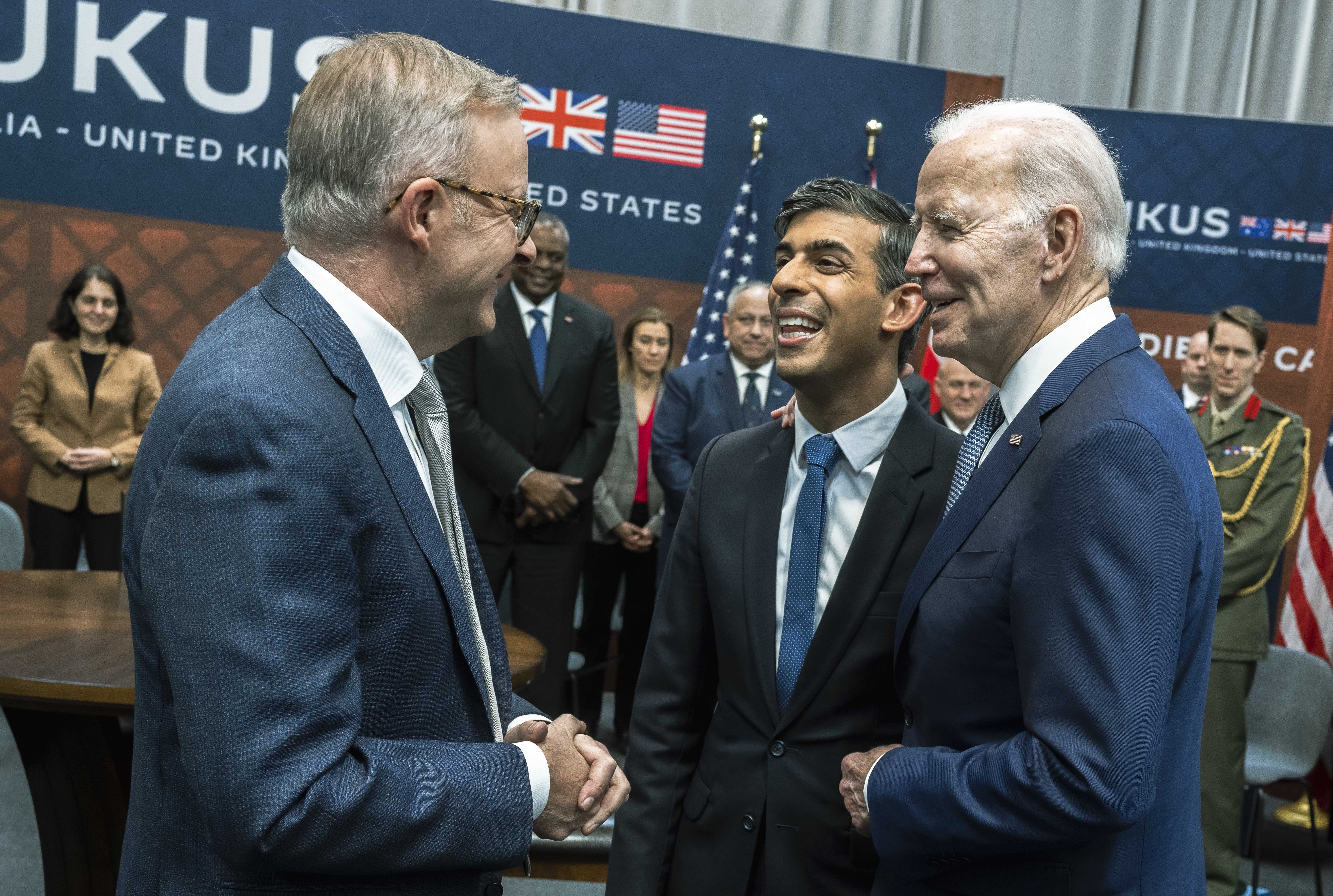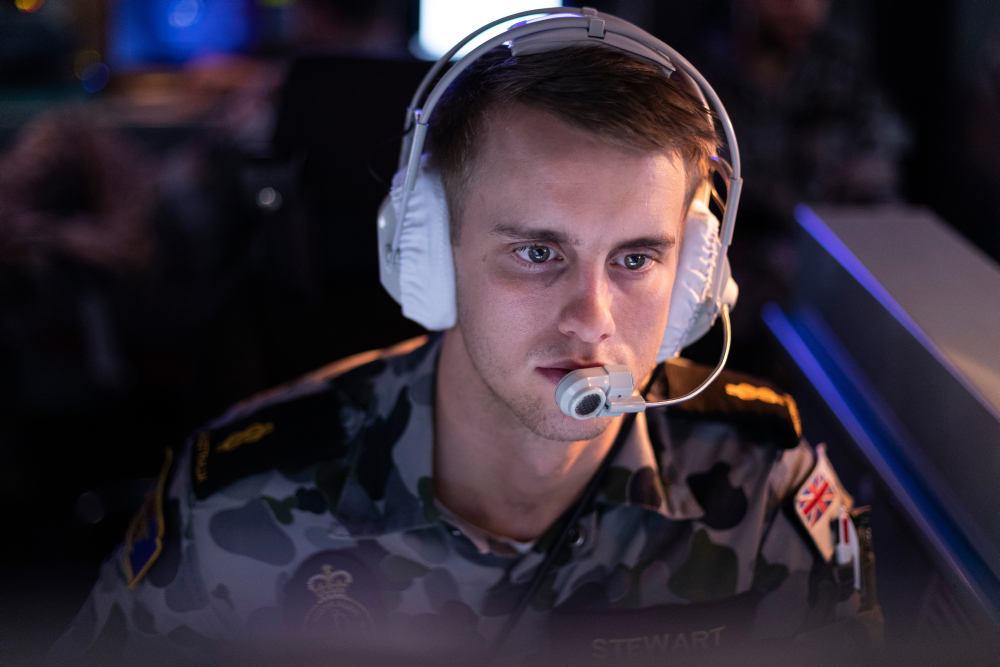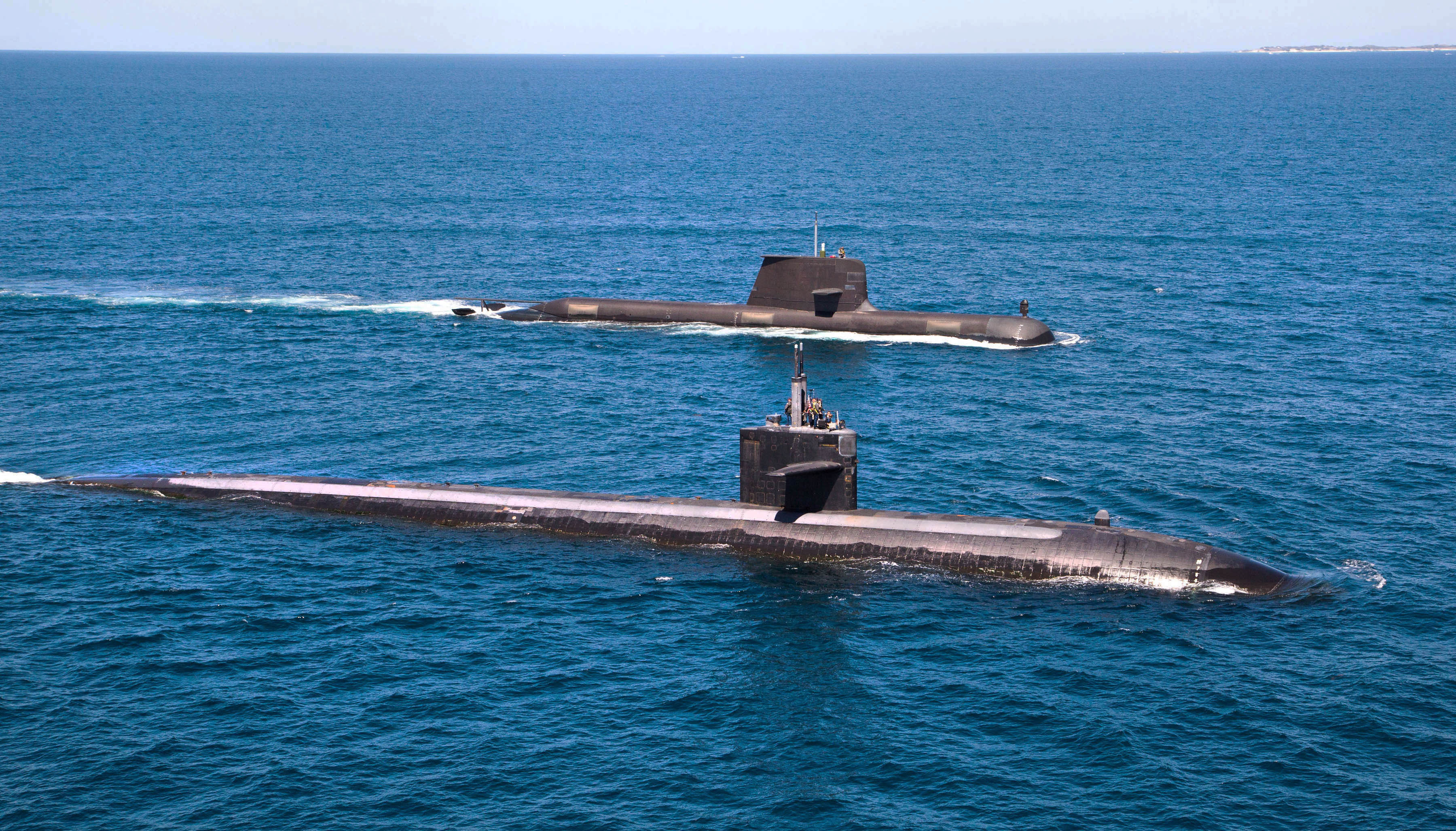
This post has been updated with additional information from the announcement ceremony.
SAN DIEGO – The leaders of Australia and the United Kingdom joined President Joe Biden at the Navy’s submarine base in San Diego, Calif., Monday to mark a historic trilateral agreement aimed at bolstering security cooperation in the Indo-Pacific region.
During the ceremony, Biden was joined by Australian Prime Minister Anthony Albanese and U.K. Prime Minister Rishi Sunak at Naval Base Point Loma to outline the basics of the technology Australia-United Kingdom-United States pact forged a year and a half ago.
AUKUS will eventually lead to Australia building and maintaining its own fleet of nuclear-powered attack boats.
The phased approach will start with training Royal Australian Navy sailors in the U.S., expanding port visits by U.S. and U.K. submarines to Australia as well as training the Australian industrial base to build and maintain the nuclear submarines.
“Nuclear propulsion is a highly complicated technology. It requires years of training to master,” Biden said.
The first group of Australian submariners already started training in the United States, and later this year, more Australian personnel will begin to “embed with U.S. and U.K. crews on boats and at bases and in schools and our shipyards.”
The increase in port visits by U.S. and U.K. subs to Australia and a rotational deployment of subs later this decade will “help develop the workforce Australia is going to need to build and maintain its fleet,” he said.
“The United States is prepared to sell Australia up to five nuclear-powered submarines, and our plan for doing so is up to three submarines at this time,” an administration official told USNI News.
Those high-tech subs “feature cutting-edge propulsion technology and provide unmatched stealth and maneuverability,” he said. If Congress approves the sale of the Virginia-class boats to Australia, it would jump-start “their undersea capability a decade earlier than many predicted.”
Although Australia would remain a non-nuclear weapons state, a nuclear-powered submarine would increase the country’s capabilities, including the longer operation range nuclear-fueled submarines have over their conventionally-powered cousins.
“We think we’ve come up with an approach that will deliver capability to Australia quicker than everyone expected, shares some of our most sophisticated technology – almost without precedent – and is constructed it in a way that really lifts both the undersea capabilities and the industrial capacity of all three nations,” one administration official told USNI.
Australia is expecting to build shipyard facilities to produce submarines in the western part of the island nation, Albanese said in an interview during a weekend visit to India.
“This is about jobs, including jobs in manufacturing, and Adelaide, in particular, will be a big beneficiary of this announcement, as will Western Australia,” the prime minister said, according to a Reuters report.
The United Kingdom has been undergoing a broad review of its defense and security forces, in part due to Russia’s war with Ukraine and China’s growing aggressive stance across the globe.
“In turbulent times, the U.K.’s global alliances are our greatest source of strength and security,” Sunak said in a statement, Bloomberg reported Sunday. “I am traveling to the United States today to launch the next stage of the AUKUS nuclear submarine program, a project which is binding ties to our closest allies and delivering security, new technology and economic advantage at home.”
AUKUS “will make a positive contribution to peace and stability in the Indo-Pacific region by enhancing deterrence,” U.S. Defense Secretary Lloyd Austin and his Australian and U.K. defense counterparts said in a statement after a December 2022 meeting at the Pentagon.
The trilateral pact has prompted sharp complaints from China. Last week, Chinese Foreign Ministry spokeswoman Mao Ning told reporters in Beijing that the three countries should “do more things that are conducive to regional peace and stability,” Bloomberg reported.
Multi-phase plan

The first phase of AUKUS is already underway, officials said. The first groups of Australian officers have joined their U.S. Navy counterparts at Nuclear Power School in South Carolina, an administration official told USNI News.
“We will increase port visits over the coming years, from both U.S. and U.K. submarines” to Perth, the official said. “We also will be embedding Australian sailors in our submarine forces and in our nuclear power schools. The first cohorts have already arrived at Nuclear Power School.”
Australians are fully committed to training their people appropriately “and take the time to do this right,” he added.
The agreement also calls for “bringing hundreds of Australian workers into the U.S. to the shipyards,” the official said. That will parallel efforts by Australia “to build up its own infrastructure” that will enable it to house and support its own submarines, as well as visiting U.S. submarines.
“Once we feel that Australia is ready to do that – and we think it could be as early as 2027 – we’ll establish a rotational force of U.S. and U.K. submarines in Australia, the construct we’re calling Submarine Rotational Forces West,” or SURF-West, the official said.
The goal of the rotational force of U.S., U.K. and Australian submarines is to put sailors “shoulder to shoulder” to help build Australia’s capacity.
Then Australia will transition to its future submarine, “a state-of-the-art platform that uses the best technologies from all three nations, a submarine we’re calling SSN AUKUS” and that’s based on a U.K. design known as SSNR, the official said. “It’ll incorporate critical and cutting-edge Virginia-class technologies from the United States. It’ll be the future submarine for both Australia and the United Kingdom,” which in turn will shore up critical supply chains and strengthen partnerships and interoperability among the countries.
The U.K. expects to deliver the SSN AUKUS “in the late 2030s,” the official said, and Australia will have its first one built in Australia for the Royal Australian Navy “in the 2040s.” That timeline will ensure there’s no capability gap as Australia retires its older submarines, he said. Those Collins-class submarines are planned to undergo service life extensions that would continue them in service until they are replaced by the new submarine.
Albanese hailed the plans to work closely with the U.S. and with the U.K. to build the new submarine for Australia’s defense forces. “This will be an Australian-sovereign capability, built by Australians, commanded by the Royal Australian Navy, and sustained by Australian workers in Australian shipyards,” he said, “with construction to begin this decade.”
The “whole-of-nation” effort behind AUKUS will provide “transformative opportunities for jobs and skills and research and innovation,” he said, noting work planned for shipyards in Adelaide and in Western Australia. Those opportunities “will shape and strengthen and grow Australia’s economy for decades and create around 20,000 direct jobs for Australians from many trade and specializations.” He added that it will also grow and support the necessary supply chains across all three countries.
“This is a genuine trilateral undertaking,” Albanese said.
In its support of AUKUS, the United Kingdom will invest more in its defense budget. Sunak announced a bump from the existing 2 percent of gross domestic product to 2.25 percent, or 5 billion pounds of additional spending over the next two years.
“This will allow us to replenish the war stock and modernize our nuclear enterprise, delivering AUKUS and strengthening our deterrence,” he said. And it’s the first step for a defense spending level at “a new ambition of 2.5 percent” that he said would allow the U.K. to remain “one of the world’s leading defense powers.”
The first of the new AUKUS subs will be built in the U.K. – at naval shipyards at Barrow and Derby – with the plan to share the process with Australia, “so they can build their own fleet,” he said.
The AUKUS subs “will also be truly interoperable,” as both U.K. Royal Navy and Royal Australian Navy will operate the same boats, he said. “And we will both share components and parts with the U.S. Navy. Our submarine crews will train together, patrol together and maintain their boats. They will communicate using the same terminology and the same equipment, and through AUKUS, we will raise our standards of nuclear nonproliferation.”
“This is a power partnership,” said Sunak. “It will mean three fleets of submarines working together across both the Atlantic and the Pacific, keeping our oceans free, open and prosperous for decades to come.”
The U.S. Navy, meanwhile, plans to wind down its purchases of Virginia-class boats in the mid-2030s as it develops the next-generation submarine, SSN(X).
No nuclear weapons

The sale of nuclear-powered submarines and sharing of sensitive and super-secret nuclear propulsion technology is as historic as it is rare. The United States “has not shared nuclear-propulsion technology to any country, except for the U.K.,” since 1958, the official said. “So this is a major shift.”
Australian officials have said they want the capabilities of nuclear-powered submarines and are not seeking nuclear weapons or nuclear weapon-capable submarines.
Administration officials said Biden insisted on adherence to standards under the non-proliferation treaty as important as U.S. officials worked closely with both Australia and the United Kingdom to develop the detailed AUKUS framework.
“This is extraordinarily important to the president,” one official said, and “we worked very closely with the IAEA (International Atomic Energy Agency) and others to make sure that is the case.”
“Australia’s commitment to making it clear that it is seeking to develop nuclear propulsion but not nuclear weapons has been indicated at every stage of the process,” the official added.





